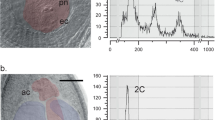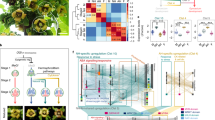Abstract
THE role of androdioecy (the presence of male and hermaphrodite individuals in a breeding population) in the evolution of dioecy has long been the subject of much interest and discussion1–9. But no functionally androdioecious species has been previously documented2 and recent studies have even raised doubt about whether the phenomenon exists at all3. Although many cases of androdioecy have been reported, most of these are based on morphological data alone and, when examined in detail, are actually found to be functionally dioecious10–12. Here we describe functional androdioecy in the flowering plant Datisca glomerata (Presl.) Baill. (Datiscaceae). We suggest that the condition evolved from a dioecious precursor, and not from hermaphroditism as is commonly postulated for the evolution of androdioecy1–9. Androdioecy in this case could be a transitional state in the breakdown of a dioecious breeding system towards hermaphroditism.
This is a preview of subscription content, access via your institution
Access options
Subscribe to this journal
Receive 51 print issues and online access
$199.00 per year
only $3.90 per issue
Buy this article
- Purchase on Springer Link
- Instant access to full article PDF
Prices may be subject to local taxes which are calculated during checkout
Similar content being viewed by others
References
Darwin, C. The Different Forms of Flowers on Plants of the Same Species (Murray, London, 1877).
Charlesworth, D. Biol. J. Linn. Soc. Lond. 23, 333–348 (1984).
Anderson, G. J. & Symon, D. E. Evolution 43, 204–219 (1989).
Bawa, K. S. A. Rev. Ecol. Syst. 11, 15–39 (1980).
Lloyd, D. G. Genetica 45, 325–339 (1975).
Ross, M. D. & Weir, B. S. Evolution 30, 425–441 (1976).
Ross, M. D. Am. Nat. 119, 297–318 (1982).
Charlesworth, B. & Charlesworth, D. Am. Nat. 112, 975–997 (1978).
Westergaard, M. Adv. Genet. 9, 217–281 (1958).
Schmid, R. Bot. Jahrb. Syst. 100, 149–195 (1978).
Anderson, G. J. Nature 282, 836–838 (1979).
Appanah, S. Biol. J. Linn. Soc. Lond. 18, 11–34 (1982).
Davidson, C. thesis, Claremont Grad. Sch., Claremont, California (1972).
Davidson, C. Aliso 8, 49–110 (1973).
Richards, A. J. Plant Breeding Systems (George Allen & Unwin, London, 1986).
Chandler, J. M., Jan, C. & Beard, B. H. Syst Bot. 11, 353–371 (1986).
Liston, A., Rieseberg, L. H. & Elias, T. S. Aliso 12, 525–542 (1989).
Wright, S. Evolution 19, 395–420 (1965).
Lloyd, D. G. & Bawa, K. S. Evol. Biol. 17, 255–338 (1984).
Charnov, E. L. The Theory of Sex Allocation (Princeton University Press, 1982).
Schlessman, M. A. Am, J. Bot. 71, 66 (abstr.) (1984).
Ornduff, R. Am. J. Bot. 51, 307–314 (1964).
Ornduff, R. Evolution 26, 52–65 (1972).
Ornduff, R. Ann. Mo. Bot. Gdn 70, 146–148 (1983).
Author information
Authors and Affiliations
Rights and permissions
About this article
Cite this article
Liston, A., Rieseberg, L. & Elias, T. Functional androdioecy in the flowering plant Datisca glomerata. Nature 343, 641–642 (1990). https://doi.org/10.1038/343641a0
Received:
Accepted:
Issue Date:
DOI: https://doi.org/10.1038/343641a0
This article is cited by
-
SWATH-MS based quantitive proteomics reveal regulatory metabolism and networks of androdioecy breeding system in Osmanthus fragrans
BMC Plant Biology (2021)
-
The de novo genome assembly of Tapiscia sinensis and the transcriptomic and developmental bases of androdioecy
Horticulture Research (2020)
-
Anatomy and RNA-Seq reveal important gene pathways regulating sex differentiation in a functionally Androdioecious tree, Tapiscia sinensis
BMC Plant Biology (2019)
-
Development and evaluation of microsatellite loci for Gynochthodes boninensis (Rubiaceae), a woody climbing plant endemic to the Bonin (Ogasawara) Islands, Japan
Journal of Forest Research (2016)
-
The differentiation and development of pistils of hermaphrodites and pistillodes of males in androdioecious Osmanthus fragrans L. and implications for the evolution to androdioecy
Plant Systematics and Evolution (2014)
Comments
By submitting a comment you agree to abide by our Terms and Community Guidelines. If you find something abusive or that does not comply with our terms or guidelines please flag it as inappropriate.



